The average 305-day milk yield of American Holsteins has increased five-fold over the past century (Miglior et al, 2017), with approximately half of the production increase attributable to genetic improvements (Cole and VanRaden, 2018). This demonstrates the remarkable genetic progress achievable with focused genetic selection. However, unfavourable genetic correlations between production and fitness traits contributed to a genetically driven decline in the fertility, health and welfare of dairy cows during the latter half of the 20th century (Jones et al, 1994; Oltenacu and Algers, 2005). A change in selection practices has reversed the direction of this trend for traits such as fertility (Berry, 2018; Cole and VanRaden, 2018), but high-producing dairy cows are still poorly adapted to some aspects of their current environment. One example of this is the intractably high prevalence of lameness in UK dairy herds. A recent meta-analysis found that, on average, around one in three dairy cows in the UK are lame at any point in time, with little indication that this high prevalence is reducing (Afonso et al, 2020).
Genetic selection
Preventive medicine and health planning are the cornerstones of farm animal veterinary practice. Genetic selection is preventive medicine in its purest form – by choosing to breed animals with a low genetic predisposition to a disease, the risk of disease in their offspring can be reduced before their offspring even truly exist. It is well-accepted that lameness can be minimised through appropriate husbandry and management; excellent industry initiatives exist to support this approach such as the AHDB Healthy Feet Programme (Bell et al, 2009; Atkinson, 2012). Genetic selection can deliver, with little additional cost, cumulative, permanent and widespread gains, to complement other efforts to reduce lameness in dairy cattle.
The goal of genetic selection is to use breeding decisions to change the average phenotypic performance of a population (eg a herd). Genetic gain relies on a proportion of the difference between animals for a given phenotype being controlled by genetic differences; this proportion is referred to as heritability. While heritability is important, it is often the extent of the genetic variation that is more important (Berry et al, 2019). If there is genetic variation underlying a trait then it can be altered through genetic selection. To achieve this, the genetic merit of each animal is estimated. This estimate is referred to as a predicted transmitting ability (PTA), which, as the name suggests, indicates how much of an animal's ability (ie phenotypic performance relative to contemporaries) is transmitted to progeny. For example, a bull with a milk yield PTA of +250 kg means that, if mated to an average dam, his daughters are expected to produce, on average, 250 kg more milk in a lactation than the average producing cow in the average herd. If genetically superior animals are consistently selected to be the parents of the next generation, then, over multiple generations, the mean genetic merit of the population will improve, along with the associated phenotypic performance. National genetic evaluations use data collected from several sources to calculate PTA for a large array of traits relating to productivity, health and welfare, calf survival, management and conformation (Winters, 2021).
Lameness traits
Lameness is a symptom of a range of conditions, predominantly foot lesions. The pathogenesis of foot lesions varies widely and the genetic background of various lesions can be very different (Heringstad et al, 2018). Foot lesion records are considered to be the ideal traits to improve foot health (van der Werf and Pryce, 2019); lesion-specific PTA can enable genetic selection to directly complement lameness control programmes that advocate a targeted approach to focus on the predominant foot lesion aetiology (eg infectious versus non-infectious). Foot trimming records are a valuable source of information for such traits and have led to the generation of lesion-specific PTA for cattle in other countries (Stoop et al, 2010; Malchiodi et al, 2020). This is the focus of ongoing research in the UK that aims to facilitate national genetic evaluations for foot lesions in the future.
To use foot trimming records for genetic evaluations, foot lesions need to be correctly identified and routinely recorded. The International Committee of Animal Recording (ICAR) has published a Claw Health Atlas (Figure 1) to internationally standardise foot lesion recording (Egger-Danner et al, 2020). Importantly, to evaluate an animal's genetic merit relating to foot lesions, both healthy and diseased animals need to be recorded. The inclusion of accurate healthy phenotypes in foot-trimming records is a major advantage to this data source compared to lameness treatment records alone. Nevertheless, foot trimming records can still be skewed towards animals with severe lesions, or at least those with more painful lesions that increase the likelihood of the animal being presented to a foot trimmer; efforts to ensure that all cows with mild lesions or without lesions are recorded as such will help produce more accurate PTA for these traits.
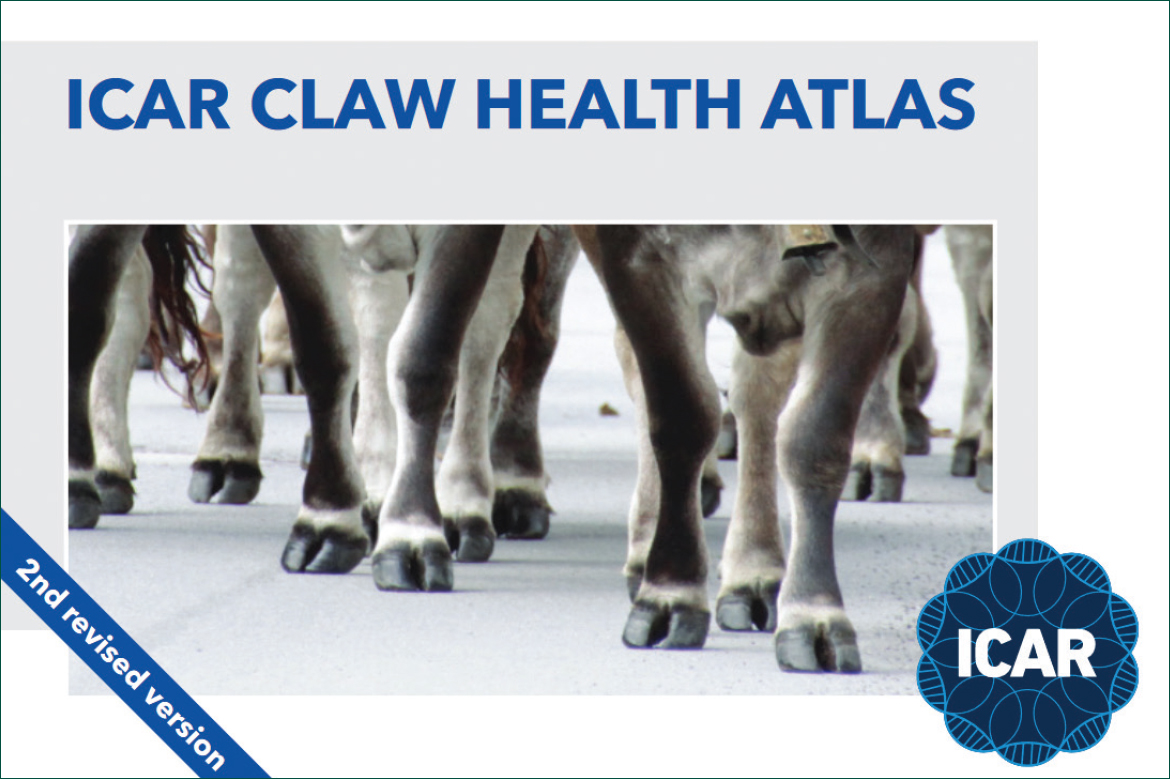
Historically, farmers wishing to improve the genetic merit for foot health in their herd have relied on PTA for linear type traits, such as feet and leg conformation, from breed society classifications of first lactation cows. More information on these traits can be found elsewhere (eg www.holstein-uk.org/virtualcow/#!/). Selection on these traits would result in better foot health if these traits were genetically correlated with foot lesions but, in reality, the strengths of these genetic correlations are often weak and vary between populations (Heringstad et al, 2018), and therefore direct selection on actual health traits is generally regarded as the most effective approach (Egger-Danner et al, 2015). The only direct foot lesion trait currently evaluated in the UK is digital dermatitis, based on a single assessment of first lactation cows during herdbook classification, where evidence of digital dermatitis is assessed in standing or walking animals (Table 1).
Table 1. Summary of traits related to foot health
| Trait | Source | Description | Advantages | Disadvantages | Currently available |
|---|---|---|---|---|---|
| Foot/limb conformation | Breed society type classification | Assessment of animal conformation such as foot angle, rear leg side view, bone quality | Relatively easy to assess and collateAll cows registered with breed societies can be phenotyped | Only assessments from first lactation cows are used in genetic evaluationsOnly available from breed society registered cowsSubjective assessmentInconsistent and generally weak association with clinical lamenessOnly an indirect association (if any) with foot lesions | Yes |
| Locomotion | Breed society type classification | Assessment of stride length, direction and limb movement. (NB different to locomotion/mobility scoring to detect lameness) | Relatively easy to assess and collateAll cows registered with breed societies can be phenotypedSimilar phenotype to the assessment of clinical lameness | Only assessments from first lactation cows are used in genetic evaluationsOnly available from breed society registered cowsSubjective assessment Inconsistent and generally weak association with clinical lamenessOnly an indirect association (if any) with foot lesionsPotential risk of selection for animals able to maintain good locomotion despite being affected by foot lesions | Yes |
| Digital dermatitis | Breed society type classification | Evidence of digital dermatitis lesions | Relatively easy to assess and collateAll cows registered with breed societies can be phenotypedDirect trait for a foot lesion | Only assessments from first lactation cows are used in genetic evaluationsOnly available from breed society registered cowsAssessed in standing/walking animal during classifying – potentially limited sensitivity | Yes |
| Lameness records | Farm records | Recorded lameness event or lameness treatment | Direct trait for non-specific lamenessRelatively easy and cheap to collect and collate via milk recording data | Lameness is generally poorly recorded in farm recordsRisk of misclassification – ‘healthy’ phenotype inferred from the absence of recorded disease, poor sensitivity of detecting lamenessLikely biased towards severe lesions | Yes (Lameness Advantage) |
| Clinical lameness | None at present – requires a central database of mobility scores or equivalent | Whole-herd mobility scoring (or equivalent) from human/video assessment or wearable sensors | Direct trait for non-specific lamenessAll animals in the herd are phenotyped so includes reliable healthy phenotypes (ie non-lame animals)Sensor or video lameness detection is objective and could provide a large number of repeated records per animal | Not currently available for national genetic evaluations – requires the development of a central databaseMobility scoring by a human is relatively subjectiveAccess to technology-derived locomotion assessments may not be possible as a result of data ownership restrictionsPotential risk of selection for animals able to maintain good locomotion despite being affected by foot lesionsLikely biased towards severe lesions | No |
| Foot lesion records | None at present – requires a central database of foot-trimming records | Individual foot lesions, ideally recorded as per the ICAR guidelines (Egger-Danner et al, 2020) and scored by severity | The most direct measure of lameness-causing diseasesNon-lame animals with mild/sub-clinical lesions (i.e. not causing a detectable lameness) can be correctly phenotyped as ‘diseased’Relatively objective if recorded as per ICAR guidelinesAllows for a different genetic background to different lesions | Not currently available for national genetic evaluations – requires the development of a central recording system and databaseLimited phenotypes from herds not engaged with routine, preventive foot-trimmingRequires compliance from foot-trimmersAll trimmers need to correctly identify and record lesionsRecords likely overrepresent lame animals or severe lesions | No |
The Lameness Advantage PTA was first published in the UK in 2018 (AHDB, 2018), and is now available for Holstein, Friesian, Ayrshire, Jersey, Guernsey, Shorthorn, Montbeliarde, Fleckvieh and Brown Swiss breeds. Eleven years ago, the number of lameness events from on-farm software in UK dairy farms was genetically evaluated. The estimated heritability of lameness was 0.03 (ie 3%), indicating that 3% of the difference in lameness incidence among cows was as a result of differences in their genetic merit (Pritchard et al, 2013). Although this heritability estimate is low (ie, similar to fertility), considerable genetic variation exists, meaning it could be used to genetically select for reduced lameness. Furthermore, as there are a large number of records available, the accuracy of selection on this trait can be very high, despite the low heritability. This trait forms a key component of the Lameness Advantage PTA, supplemented with information from breed society conformation classification: digital dermatitis, bone quality, locomotion, and feet and legs. Feet and legs is a composite index from the overall assessment by the classifier incorporating foot angle, rear legs side view, locomotion and bone quality. The Lameness Advantage PTA is expressed as a percentage, usually from −5% to +5%, with higher values reflecting better genetic merit for foot health (Winters, 2021). In 2020, a standalone digital dermatitis PTA was published, using records of digital dermatitis lesions from breed society classification. Similar to Lameness Advantage, higher values indicate a reduced genetic predisposition to digital dermatitis (AHDB, 2020).
The relationship between the Lameness Advantage PTA and claw horn lesions (ie sole haemorrhage, sole ulcers and white line lesions) has been assessed using repeated veterinary examinations to record foot lesions and lameness in 2352 Holstein cows on four commercial UK herds (Barden et al, 2022). The results indicated that the higher a cow's Lameness Advantage PTA, the lower the likelihood of sole ulcers, sole haemorrhage and lameness. Higher Lameness Advantage PTA was also associated with a reduced likelihood of cows developing digital dermatitis, but a stronger effect was observed with the digital dermatitis PTA, where 51% of cows with a digital dermatitis PTA between −1 and −0.5 had digital dermatitis, compared to 25% of those with a PTA between +0.5 and +1 (Anagnostopoulos et al, 2023).
Figure 2 shows the relationship between the proportion of lame cows (based on mobility scoring) and the Lameness Advantage PTA of either the cows themselves (A) or their sires (B), aggregated for four UK herds (Barden et al, 2022). Although these results only relate to four herds, Figure 2A shows the potential reduction in lameness as the Lameness Advantage PTA increases. Figure 2B shows the advantage of avoiding bulls with a poor Lameness Advantage PTA, which is a breeding strategy that could be implemented quickly, cheaply and easily on most dairy farms.
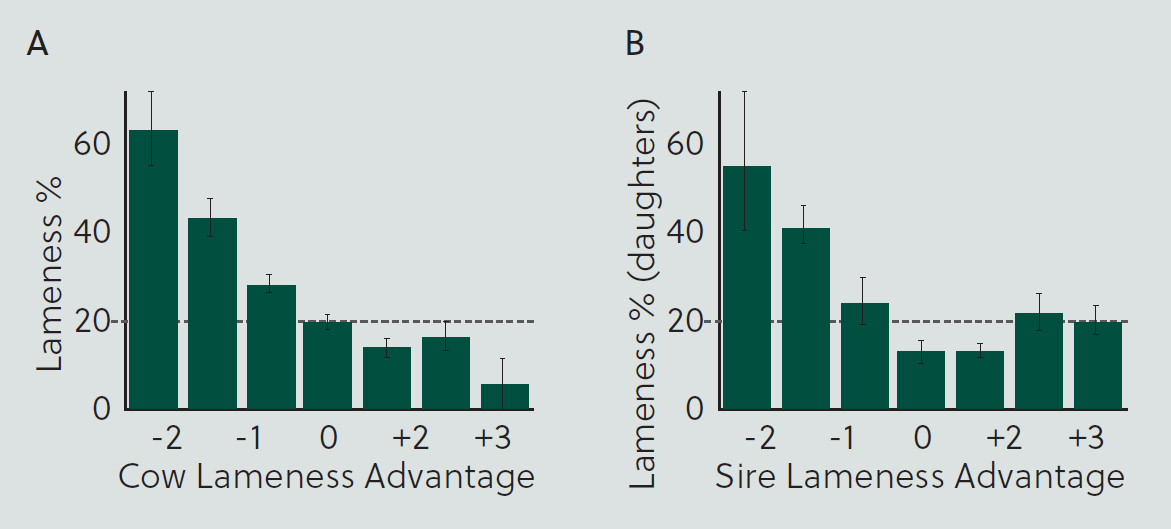
In the previously described study of four UK dairy herds (Barden et al, 2022), other PTA, such as locomotion and feet and legs, were also evaluated for their association with claw horn lesions and lameness. Although favourable PTA values for locomotion and feet and legs were associated with a reduced chance of cows being mobility scored as lame, there was no association with the presence of claw horn lesions. This suggests that selection on these PTA may be effective for breeding cows that are less likely to exhibit lameness, but without reducing the chances of these cows developing claw horn lesions. One of the challenges in detecting foot lesions in cattle is their natural stoicism, possibly because of the evolutionary advantage of masking signs of pain from potential predators. It is important, therefore, not to exacerbate this problem by selectively breeding cows that are more likely to appear sound despite the presence of foot lesions.
Accelerating genetic progress
Genetic selection produces long-term and cumulative benefits. The expected response to genetic selection can be estimated using the breeder's equation (Figure 3) (Rendel and Robertson, 1950). By improving at least one of the components of this equation, without compromising the others, genetic progress in a population (eg a herd) can be accelerated.

Intensity of selection reflects the proportion of animals at one extreme of the distribution that are selected as parents of the next generation. For example, all else being equal, a greater response to selection would be expected if a herd only used bulls with a Lameness Advantage PTA of +2 or greater, rather than bulls with a Lameness Advantage PTA greater than zero. The intensity of selection can be further increased with the selection of females; for example, by breeding replacements from heifers or cows with the highest Lameness Advantage PTA.
Accuracy of selection refers to how closely the PTA reflects the true genetic value of an animal for the trait(s) in question. The estimated accuracy of a PTA is the square root of the reliability, which is a metric published alongside PTA. The accuracy of a PTA reflects how much phenotypic and/or genomic information exists on the animal itself, its ancestors and its descendants. It is important to note that even with a low heritability trait like lameness, a large number of progeny records can contribute to a high accuracy. In the August 2023 UK national genetic evaluation, there were 174 available Holstein bulls with a Lameness Advantage PTA reliability of at least 70% (ie accuracy of at least 84%).
Genetic variability refers to the extent of the genetic differences that underlie the observed differences in a trait. The genetic variability of a trait is largely out of our control, although genetic variation in a population generally reduces as inbreeding accumulates. Figure 4 shows the spread of Lameness Advantage PTA of Holstein bulls in the August 2023 genetic evaluation with a reliability of at least 70%; there is plenty of genetic variation for this trait to use in breeding programmes.
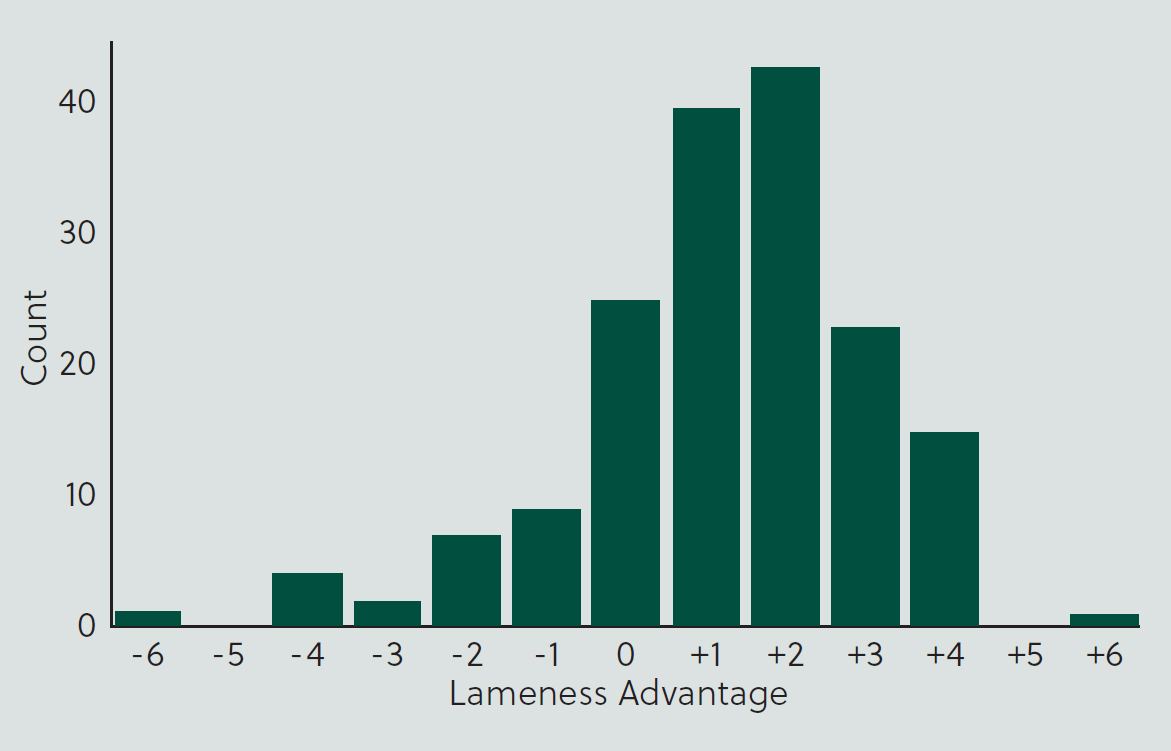
Generation interval is the average age of the parents when offspring are born, who themselves go on to become parents of the next generation. All else being equal, the shorter the generation interval, the greater the annual genetic gain. The average age of dairy bulls, when mated to females, has reduced because bulls are now selected using genomic information available at birth; this has contributed to a shortening of the generation interval (García-Ruiz et al, 2016). Furthermore, genomically testing heifers to identify and breed replacements from those with superior genetic merit can further reduce the generation interval in a herd and accelerate genetic gain.
Breeding for reduced lameness
Bull selection is the easiest way to implement genetic selection. It is important to know the genetic merit of a herd before selecting bulls; the ADHB Herd Genetic Report provides this information. Genetic gain is greatest when the genetic merit of selected bulls is superior to those of the cows in the herd. It is also useful to consider the distribution of the PTA of interest in the herd because it highlights the opportunity to use the tails of the distribution to increase selection intensity by also using female selection. For example, the quickest way to increase the average Lameness Advantage PTA in a herd is to remove the animals with the lowest PTA (or breed them to beef) and only breed replacements from animals with the highest PTA; nonetheless, a balanced approach to selection is still essential.
Total merit indexes are designed to support balanced selection and are comprised of the weighted sum of estimates of genetic merit for multiple traits affecting profitability, including production, health and functionality. Individual traits are weighted by their relative economic importance so that the indexes represent the expected financial return from progeny, compared to the average animal. The Profitable Lifetime Index (£PLI) is calculated for year-round calving herds, while the Spring Calving Index (£SCI) and Autumn Calving Index (£ACI) are for seasonal herds (AHDB, 2020). Lameness Advantage is included in the economic indexes; however, as it is only one of many traits in these indexes, animals can have high £PLI (or £SCI/£ACI) without necessarily having favourable genetic merit for foot health.
One pragmatic approach to breed for better foot health is to sort the available bulls by £PLI (or £SCI/£ACI) and select bulls with a high Lameness Advantage PTA from the top of this list (ie those with a high £PLI), while ensuring acceptable genetic merit for other important traits. Figure 5 shows the £PLI and Lameness Advantage values of available Holstein bulls from the August 2023 UK national genetic evaluation with a Lameness Advantage reliability of at least 70%; herds aiming to breed for better foot health should consider bulls as close to the top right of the graph as possible.
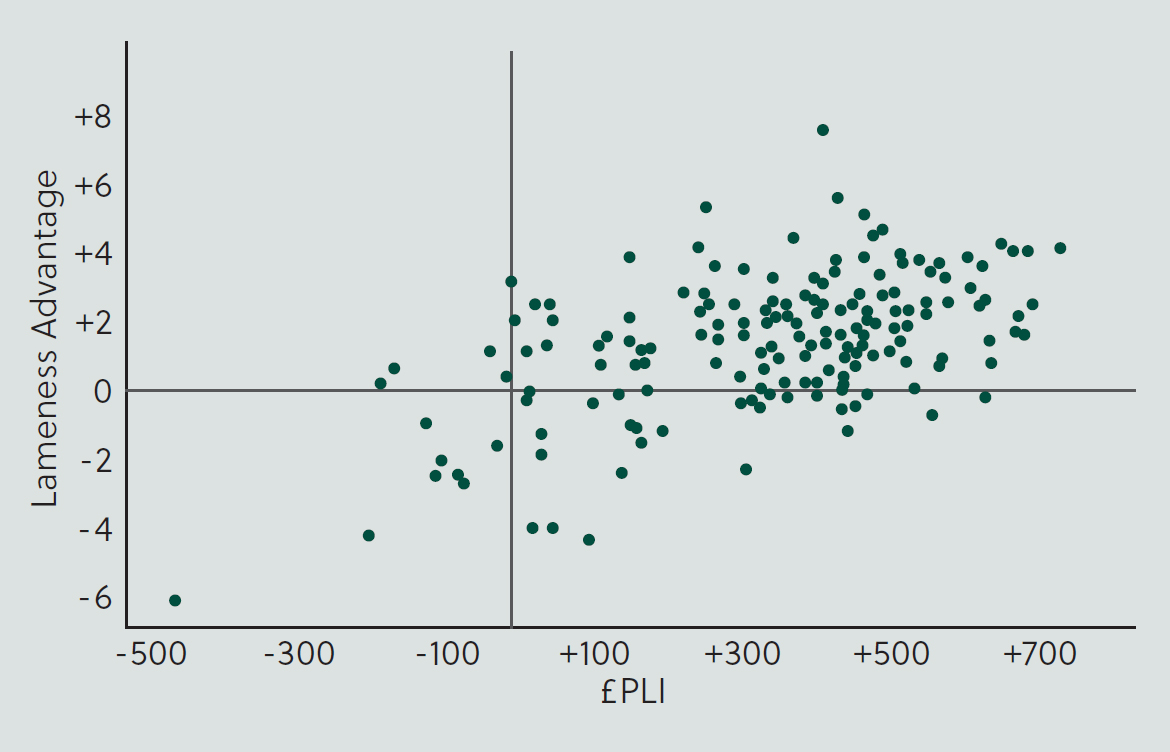
The AHDB Herd Genetic Report can also be imported into farm data analysis software, such as Total Vet (QMMS, Wells, UK) to visualise the genetic merit of the herd and to determine the strength of the relationship between genetic merit and performance. For example, farm records of lameness can be plotted against the animals' Lameness Advantage PTA (Figure 6). The average and distribution of Lameness Advantage PTA in animals without any recorded lameness treatments (‘never’) compared to those recorded with at least one lameness treatment (‘ever’) can be assessed; this can be useful to demonstrate the potential benefit of selecting on the Lameness Advantage PTA in a herd.
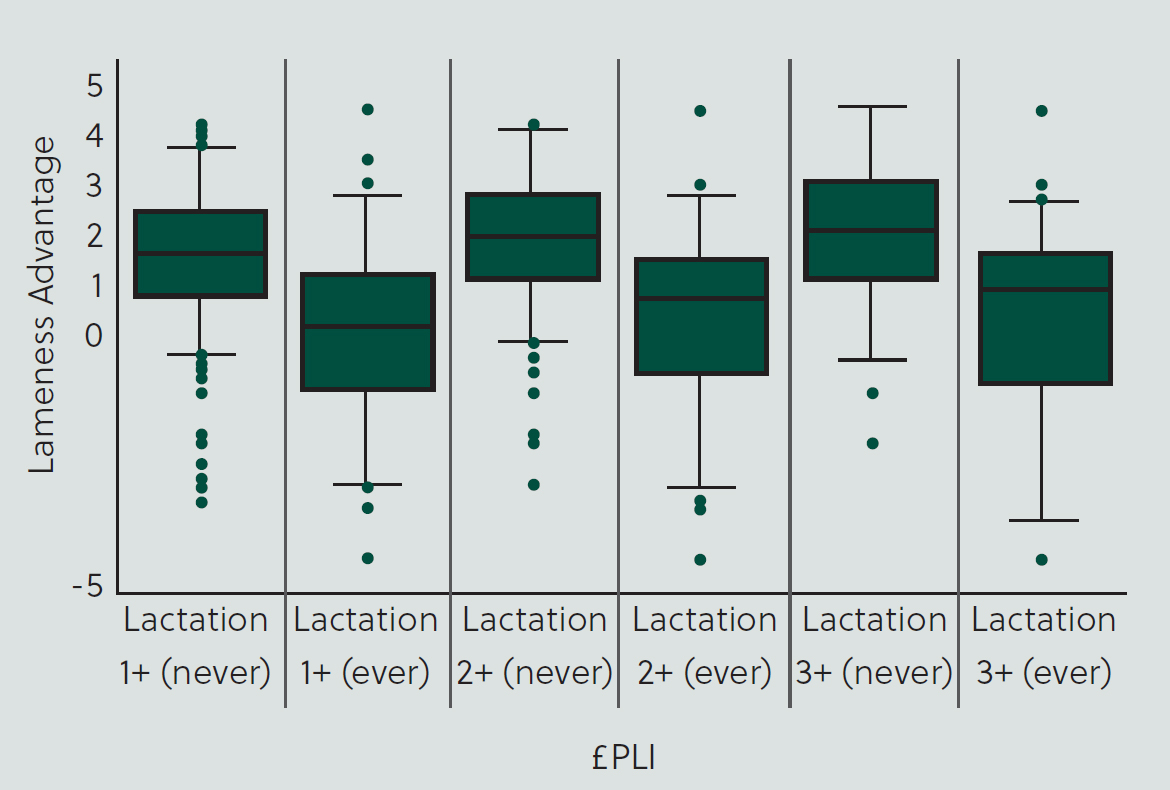
Finally, one frequent concern about selecting for reduced lameness is that this may inadvertently select against milk production. In the currently available Holstein bulls with a Lameness Advantage PTA reliability of at least 70%, there are favourable correlations between the Lameness Advantage PTA and the PTA for milk kg (+0.33), protein kg (+0.38) and fat kg (+0.33). Therefore, the correlated response from selecting bulls with a high Lameness Advantage PTA would, on average, be increased genetic merit for milk, protein and fat production; however, the safest approach would be to select high £PLI (or £SCI/£ACI) bulls that also have high Lameness Advantage and production PTA, as well as being genetically superior for other traits of interest to the herd breeding programme.
Conclusions
Lameness in dairy cattle is one of the most pressing issues affecting the industry. Farmers need a toolbox of solutions to reduce the prevalence of lameness in their herds. Genetic selection is one such tool and should form part of an overall herd strategy that already considers management and environmental aspects. The Lameness Advantage PTA has been demonstrated to be associated with a reduced incidence of sole lesions, digital dermatitis and lameness. Therefore, increasing the average Lameness Advantage PTA of cows may help reduce the incidence of lameness. In the future, foot lesion-specific PTA could be available which would support a more targeted approach to breeding for better foot health; this is, however, conditional on access to routine foot-trimming records in national genetic evaluations.
KEY POINTS
- Lameness is a multifactorial condition that requires multifactorial solutions – this includes breeding to improve foot health alongside improvements in herd management and the environment.
- The Lameness Advantage predicted transmitting ability (PTA) supports breeding cows that are less likely to develop sole lesions, digital dermatitis or lameness.
- The digital dermatitis PTA supports breeding cows that are less likely to develop digital dermatitis.
- Selecting bulls with a high Lameness Advantage PTA is a low-cost strategy to produce long-term and cumulative benefits, provided the selection strategy is balanced and does not neglect other important traits.
- The quickest way to improve herd genetic merit for foot health is to select high Lameness Advantage PTA female animals as well as bulls – only breed replacements from cows with the highest Lameness Advantage PTA and breed those with the lowest Lameness Advantage PTA to beef.
- Genetic indexes for specific foot lesions may be available in the future but rely on routine access to foot-trimming records.


